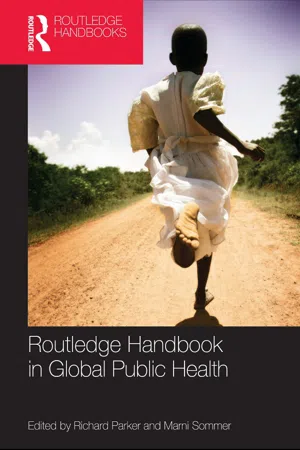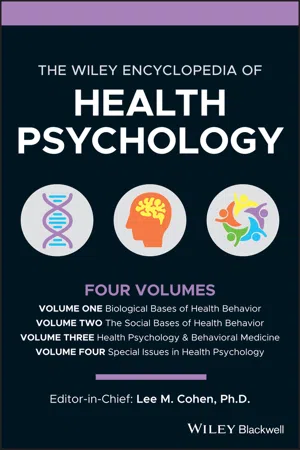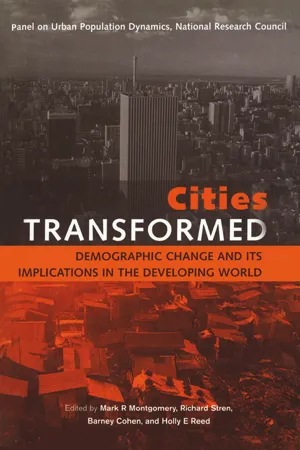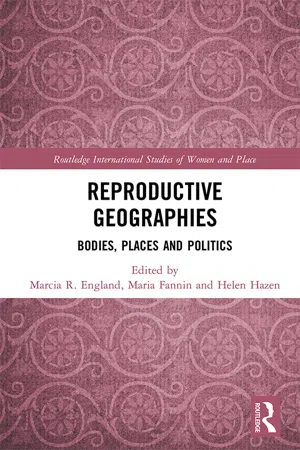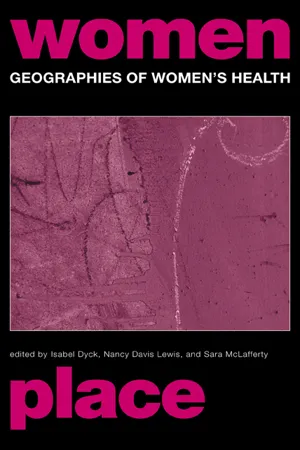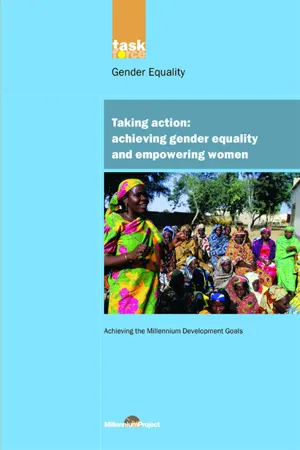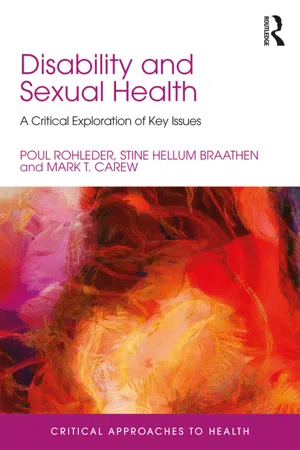Geography
Reproductive Health
Reproductive health refers to the physical, mental, and social well-being in all matters relating to the reproductive system. It encompasses a wide range of issues such as family planning, maternal health, sexually transmitted infections, and access to reproductive healthcare services. Geographical factors can significantly impact access to reproductive health services and outcomes, making it an important consideration in geographic studies.
Written by Perlego with AI-assistance
Related key terms
8 Key excerpts on "Reproductive Health"
- eBook - ePub
- Richard Parker, Marni Sommer, Richard Parker, Marni Sommer(Authors)
- 2010(Publication Date)
- Routledge(Publisher)
Reproductive Health is a state of complete physical, mental and social well-being and not merely the absence of disease or infirmity, in all matters relating to the reproductive system and to its functions and processes. Reproductive Health therefore implies that people are able to have a satisfying and safe sex life and that they have the capability to reproduce and the freedom to decide if, when and how often to do so. Implicit in this last condition are the right of men and women to be informed and to have access to safe, effective, affordable and acceptable methods of family planning of their choice, as well as other methods of their choice for regulation of fertility which are not against the law, and the right of access to appropriate health-care services that will enable women to go safely through pregnancy and childbirth and provide couples with the best chance of having a healthy infant. In line with the above definition of Reproductive Health, Reproductive Health care is defined as the constellation of methods, techniques and services that contribute to Reproductive Health and well-being through preventing and solving Reproductive Health problems. It also includes sexual health, the purpose of which is the enhancement of life and personal relations, and not merely counselling and care related to reproduction and STIs.(United Nations 1994 : para. 7.2)Clearly, the concept of reproductive rights is embedded in the definition of Reproductive Health. In the subsequent paragraph, the Programme of Action described reproductive rights as:embrac[ing] certain human rights that are already recognised in national laws, international human rights documents and other relevant UN consensus documents. These rights rest on the recognition of the basic right of all couples and individuals to decide freely and responsibly the number, spacing and timing of their children and to have the information and means to do so, and the right to attain the highest standard of sexual and Reproductive Health. They also include the right of all to make decisions concerning reproduction free of discrimination, coercion and violence. Full attention should be given to promoting mutually respectful and equitable gender relations and particularly to meeting the educational and service needs of adolescents to enable them to deal in a positive and responsible way with their sexuality. - eBook - ePub
- (Author)
- 2020(Publication Date)
- Wiley-Blackwell(Publisher)
Reproductive HealthJennifer L. Brown1 and Nicole K. Gause21 Department of Psychiatry and Behavioral Neuroscience, University of Cincinnati College of Medicine, Cincinnati, OH, USA 2 Department of Psychology, University of Cincinnati, Cincinnati, OH, USAAs defined by the World Health Organization (WHO), Reproductive Health refers to the well‐being of reproductive processes throughout all stages of life; this includes the ability to have satisfying and safe sex, as well as the ability to reproduce (WHO, 2016a ). Additionally, Reproductive Health involves the capability to decide when and how often to engage in sexual and reproductive behaviors (WHO, 2016a ). According to the WHO, to maintain Reproductive Health, men and women should also have access to safe, effective, and affordable contraception, as well as access to healthcare services that facilitate healthy pregnancies and childbirths (WHO, 2016a ).This chapter provides an overview of Reproductive Health issues that may be of clinical relevance to a health psychologist. Effective strategies for conducting sexual health histories to assess patients' sexual behavior engagement and sexual orientation are provided. Sexual behaviors that are associated with increased risk for adverse sexual health consequences such as sexually transmitted infections (STIs) and unintended pregnancies are described. Epidemiological data regarding STI prevalence is provided, as well as an overview of efficacious human immunodeficiency virus (HIV) and STI prevention intervention approaches. Modern contraceptive options that provide safe, effective methods of pregnancy prevention are discussed. Disorders related to patients' sexual health including sexual dysfunction disorders, hypersexuality, and paraphilic disorders are discussed, as well as relevant diagnostic considerations and efficacious treatment options. A brief summary of sexual behavior engagement from a developmental perspective is provided at the end of the chapter. - eBook - ePub
Cities Transformed
Demographic Change and Its Implications in the Developing World
- Mark R. Montgomery, Richard Stren, Barney Cohen, Holly E. Reed(Authors)
- 2013(Publication Date)
- Routledge(Publisher)
6 Fertility and Reproductive HealthMany aspects of urban life have the potential to affect fertility and Reproductive Health, but not all of these can be said to be distinctively urban. The broad features of the urban economy—its dominance by industry and services, its workplaces situated outside the home—were noted so long ago in discussions of the demographic transition (Notestein, 1953) that they have almost ceased to be regarded as urban. Indeed, as discussed earlier in this report, many rural areas have been assuming similar characteristics, especially in the regions surrounding large cities. Lower infant and child mortality is also broadly characteristic of cities, and lower mortality reduces some of the risks parents face in adopting strategies of low fertility. But the mechanisms are not obviously urban in character; surely lower mortality would exert much the same sort of influence in rural villages. Migrants are a distinctive presence in urban environments, and the fact that they have recently made transitions from other contexts raises issues of disruption, adjustment, and selectivity. Apart from migration, however, there remains the question of what is gained by situating fertility and Reproductive Health decisions within specifically urban contexts. What does this “embedding” achieve? Does it bring to light any implications for services and programs?To begin, we should offer a word of explanation on the meaning of the phrase “Reproductive Health.” It refers to “a state of complete physical, mental, and social well-being and not merely the absence of disease or infirmity, in all matters relating to the reproductive system and its processes” (United Nations, 1994: 202). The concept provides a framework for thinking about sex and reproduction, highlighting not only family planning, conception, and birth, but also the imbalances in decision-making autonomy between men and women, the possibilities of coercion and even violence in their relations, and the different health risks to which they may be knowingly or unknowingly exposed. A broad perspective is especially helpful where adolescents are concerned, because young men and women are often woefully ignorant about matters of conception and health risk, are still testing the limits of their autonomy in decision making vis-à-vis their elders and the other sex, and yet must often make choices that can foreclose options for adult life and compromise their later decision-making powers. Programs in the area of Reproductive Health include those dealing with contraception, but also encompass initiatives aimed at sexual violence; reproductive tract infections; and sexually transmitted diseases (STDs), including HIV/AIDS. They extend as well to services intended to ensure healthy pregnancies and deliveries and safe abortion. - eBook - ePub
Reproductive Geographies
Bodies, Places and Politics
- Marcia England, Maria Fannin, Helen Hazen, Marcia R. England, Maria Fannin, Helen Hazen(Authors)
- 2018(Publication Date)
- Routledge(Publisher)
All of these examples illustrate how the spatial and temporal dimensions of fertility, pregnancy and birth are undergoing significant transformations. These new technologies have the potential to extend understandings of reproduction, fertility and kinship in new directions, made possible by the mobility of bodily tissues and the expansion of who is able to conceive. For critics, these processes are inappropriate technological interference in natural processes. For supporters, ARTs provide ways to address fertility inequalities. Jurgen De Wispelaere and Daniel Weinstock (2014) discuss state assistance for ARTs for infertile citizens arguing for “positive rights” to reproduce, which should involve financial subsidisation by the state. As Barbara K. Rothman has argued, “The treatment of infertility needs to be recognized as an issue of self-determination. It is as important an issue for women as access to contraception and abortion, and freedom from forced sterilization” (quoted in Berg 1995, 103). In addition to Rothman’s emphasis on self-determination, the concept of “stratified reproduction” explores the social and cultural barriers to reproduction and the power relations and inequalities embedded in ARTs—specifically, the empowerment of those who are seen as better able to nurture and reproduce due to marital status, sexuality or affluence, in contrast to those who are disempowered (Culley et al. 2009).Geographical approaches to reproduction
As this discussion shows, reproductive justice movements and new reproductive technologies are raising important questions about the changing social and spatial dimensions of reproductive life. Geographers have a long history of exploring reproductive phenomena. Traditionally, however, much of this work has occurred within population geography, focusing particularly on the implications of fertility patterns for wider patterns of population growth and decline. Geographers have been critical to helping shape the “demographic imagination” in which birth, life and death became objects of scientific and political concern. James Tyner (2013, 702) argues that population geographers need to further consider the politics of fertility as well as mortality and mobility to move from simple demographic questions towards a critical approach that asks: “Within any given place, who lives, who dies, and who decides?” A focus on reproductive geographies encourages us to apply this question to the start of life as much as it has historically been focused on its end.The last three decades of critical and feminist geographical work has diversified approaches to reproductive issues, with a burgeoning interest in the experiential and political dimensions of reproductive processes. These works argue for expanding geographical accounts of reproduction to a wider array of experiences and subjects, as well as to recognising the politicised and politicising dimensions of reproductive life. Phenomenological and socio-cultural accounts of the embodied experience of the body’s fluidity in pregnancy and birth have been developed by feminist geographers such as Robyn Longhurst in a series of works (Longhurst 2001, 2008; see also Teather 1999). Longhurst’s Maternities: Gender, bodies, and space - eBook - ePub
Geographies of Women's Health
Place, Diversity and Difference
- Nancy Davis Lewis, Isabel Dyck, Sara McLafferty, Nancy Davis Lewis, Isabel Dyck, Sara McLafferty(Authors)
- 2012(Publication Date)
- Routledge(Publisher)
do and the environments in which they live are changing. The opportunities and resources for improving health are being transformed in the context of social, economic, and technological processes which affect the types of work women and men engage in and the organization of reproduction. In the developing world, economic recession, structural adjustment, environmental deterioration, and ethnic strife have had special ramifications for the health – or ill-health – of women. Similar concerns are emerging in Eastern Europe and the former Soviet Union, where the health impacts of decades of environmental degradation are only now being revealed. Around the globe, women’s increasing participation in the paid labor force, widening class divisions, and restructuring of health and social services are reshaping women’s health and access to health care. In addition, the international financial community’s belated recognition of women’s role in economic development has increased the burdens on women, responsible now not only for their own health, but for that of their families, the environment – and the economy.Until recently the contribution of geography has been largely absent in these investigations of women’s health. With this volume, in which many but not all authors are geographers, we begin to fill that lacuna. We explore a wide range of issues concerning women’s health, and suggest ways in which geographic inquiry can further our understanding of the health of women. As in other social science disciplines, we move away from a medical focus to a broader understanding of health, locating the discussion within political and economic processes and social change. How such processes play out in particular places brings a distinct geography to women’s health issues and to their health care, whether as consumers or providers. How women’s health is defined and responded to, what conditions produce health or ill-health, and what resources are available to women as they manage their own or their families’ health and illness are all shaped within particular polities, economies, and cultural discourses about gender.The authors of the chapters employ both qualitative and quantitative methodologies in their inquiries and the approaches taken are diverse and representative of the many lenses now being employed in understanding the health of women. Running through many of the contributions is the inclusion of women’s own perspectives of health and illness and ways of managing health. These bring further nuances to the depiction and understanding of the complex interactions between place, gender, and health. The chapters suggest the importance of both traditional research approaches and women-centered methods in understanding women’s health. What is significant in these accounts is that women are rarely best viewed as “victims,” but should be seen as women exploring and using active strategies in managing health and illness and accessing both formal and informal health care systems. Together the chapters begin to tease out relationships between society, place, gender, and health, and how these play out in different parts of the world. They reflect the changing concerns of inquiry in the field of women’s health; chapter topics take us beyond the confines of medical definitions, medical sites, and biomedical provinces of knowledge to other areas, both conceptually and spatially beyond the clinic. - eBook - ePub
UN Millennium Development Library: Taking Action
Achieving Gender Equality and Empowering Women
- UN Millennium Project(Author)
- 2013(Publication Date)
- Routledge(Publisher)
Today, these rights are threatened by actions to limit and withdraw funding from effective Reproductive Health programs, censor or distort information and research on comprehensive health interventions and issues, and renege on previous international agreements on sexual and Reproductive Health and rights. Such actions threaten the progress of the last 10 years in improving women's Reproductive Health and may worsen the Reproductive Health status of poor women around the world.Links between Reproductive Health and other domains of gender equalitySexual and Reproductive Health and rights are important for gender equality in education and access to economic resources, as well as for women's empowerment.Education. The links between secondary education and Reproductive Health are discussed in chapter 3 . Note, too, that early marriage reduces girls’ access to education and that anticipation of an early marriage often precludes secondary education for girls (Huq and Amin 2001).Economic resources. Access to Reproductive Health is often a precondition for access to economic assets and resources and opportunities to employ them productively. For example, access to family planning allows women to balance the size of their family and timing of their children with their need and desire to earn income, as many studies have shown. The ability to control their fertility also allows women to seek additional education or training, prepares them for better employment, and permits them to take part in other desirable activities such as community affairs (Family Health International 1998). For example, research has shown that women who begin childbearing before age 20 complete less schooling than women who delay having children until their 20s (Johns Hopkins School of Public Health 1999a).Each year half a million women die of preventable complications of pregnancy and childbirth and another 18 million are left disabled or chronically ill
Women's economic status can in turn affect Reproductive Health outcomes. Women's economic dependency makes them more vulnerable to HIV and other sexually transmitted infections. Research from around the world has shown that when women are economically vulnerable, they are less able to negotiate the use of condoms or other forms of safer sex, less likely to be able to leave a relationship that they perceive to be risky, and more likely to increase their risk by exchanging sex with multiple partners for money or goods (Rao Gupta and Weiss 1994). - eBook - ePub
Geographies of Care
Space, Place and the Voluntary Sector
- Christine Milligan(Author)
- 2017(Publication Date)
- Routledge(Publisher)
2 Geographical Perspectives on Health IntroductionAs care has moved from institutional to community-based sites of delivery, concern has focused not only on the relocation of the locus of care, but also on the new sets of actors and agencies involved with its planning and provision. Attention is drawn to the ways in which decisions are made and how the social processes of care reform operate in particular places. The relationship between healthcare and the means through which social, cultural, political and economic influences alter the experience of health and illness across space and within places has been of particular interest to medical geographers in recent years.The study upon which this book is based builds on work that has emerged from several strands of contemporary geographical thinking. Such work maintains that for a clearer understanding of how and why specific patterns of health and healthcare emerge in particular places at particular times, there is a need to extend the focus of medical geography to incorporate a wider view of health and healthcare. These broadly embody the recognition of a need to move away from bio-medical approaches to the geographical analysis of health issues, to incorporate social models of health and healthcare. Such approaches also highlight the potential benefit of integrating multi-disciplinary perspectives to geographical analyses, and the need to understand how wider contextual factors impact on experiences of health and healthcare. To understand why these issues are of importance here, this chapter gives a brief history of the development of medical geographical thinking, identifying some of the main elements that have informed the study. In doing so, I discuss some of the main ‘traditional’ theoretical and epistemological positions through which aspects of health and illness have been examined within medical geography, and how development in thought across the discipline as a whole has become manifest in terms of “contemporary’ perspectives in geographies of health and healthcare. - eBook - ePub
Disability and Sexual Health
A Critical Exploration of Key Issues
- Poul Rohleder, Stine Hellum Braathen, Mark Carew(Authors)
- 2018(Publication Date)
- Routledge(Publisher)
Provision of sexual and Reproductive Health care is vital to ensure that people can lead pleasurable, safe sex lives and make free, informed choices about whether to start families together. Sexual and Reproductive Health care covers a range of services, including screening and treatment for STDs, assistance with family planning, and delivery of antenatal, perinatal and postnatal care. Leading a healthy sexual life is important for each and every person, including for people with disabilities. In light of this, it should be of no surprise that access to the highest possible standard of sexual health care is recognised globally as a human right for all (WHO, 2009). The literature assessing access to such care in the context of disability has typically focused on the needs of professionals and the level of support they should deliver to service users (e.g. Bitzer, Platano, Tschudin & Alder, 2007; Fronek, Kendall, Booth, Eugarde, & Geraghty, 2011; Post, Gianotten, Heijnen, Lambers, & Willems, 2008; Rueda, Linton, & Williams, 2014). However, as outlined in the previous section, people with disabilities face disparities in health care due to a confluence of structural/environmental (e.g. inaccessible buildings) and attitudinal (e.g. negative views of service utilisation) barriers. A critical health perspective emphasises that it is these barriers that need to be the focus of efforts aiming to ensure equitable health care for people with disabilities (Eide et al., 2015), including in the area of sexual and Reproductive Health care.One such barrier is difficulty getting to and from sexual and Reproductive Health care facilities. This can be particularly problematic for people with physical disabilities living in low-income countries (Braathen et al., 2016; Mavuso & Maharaj, 2015; Smith, Murray, Yousafzai, & Kasonka, 2004). In these places, the provision of accessible public transportation is often poor, while private alternatives (e.g. taxis, own car) may be too costly. At the same time, due to poor infrastructure, the nearest health facility may be located several hours walk away, leaving journeys from home without transportation difficult, if not impossible, for many (Vergunst, Swartz, Mji, MacLachlan, & Mannan, 2015). An additional complication is that many people with disabilities also require someone to accompany them to visit services, which can incur extra transportation costs and limit the period of time during which travel can be undertaken (Mavuso & Maharaj, 2015). These issues may pose particular challenges when people with disabilities require emergency care (Vergunst et al., 2015) and may deter them from maintaining healthy behaviours in general (e.g. replenishing contraceptive supplies; Mavuso & Maharaj, 2015). Although difficulty travelling to health services is a barrier most common within low-income countries, it is present in high-income countries also, notably within rural settings (Daley et al., 2011; Iezzoni et al., 2006). Moreover, in both low- and high-income countries, travel to sexual health services can be obstructed by historical conflicts and inequalities that continue to trouble the contemporary spaces that people with disabilities inhabit. For instance, in Northern Ireland, where the vast majority of the population have strong ties to Protestantism or Catholicism, people with disabilities may be reluctant to attend services located in areas perceived as belonging to members of the other group (Anderson & Kitchin, 2000). A second example is South Africa, where many people with disabilities live in areas where infrastructure is poor due to historical policies under Apartheid, which left some areas of the country underdeveloped (Emmett & Alant, 2006; Vergunst et al., 2015).
Index pages curate the most relevant extracts from our library of academic textbooks. They’ve been created using an in-house natural language model (NLM), each adding context and meaning to key research topics.
